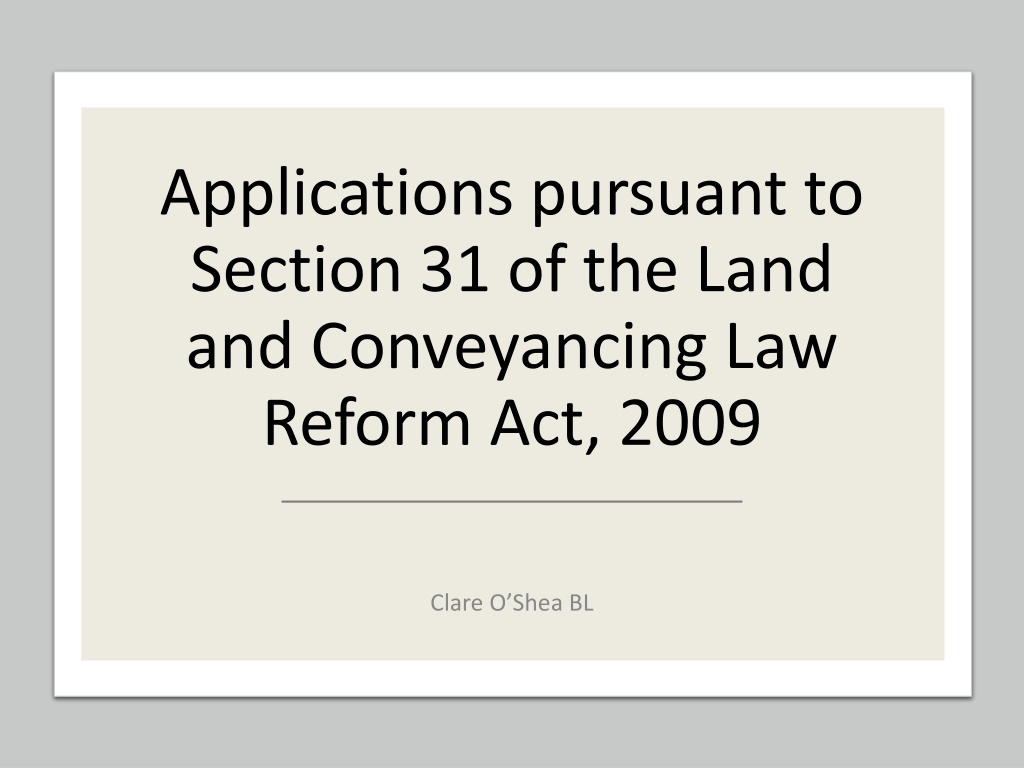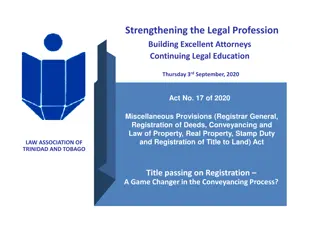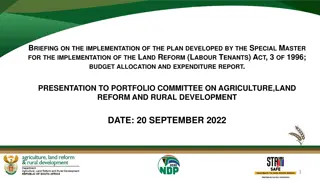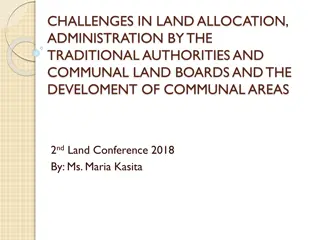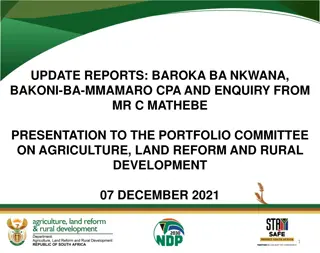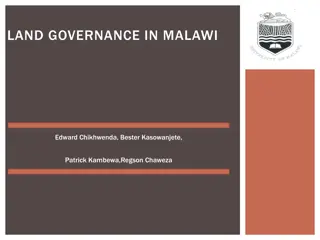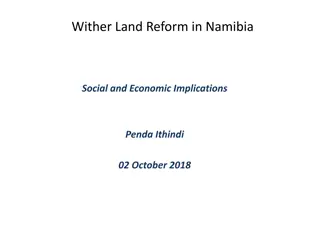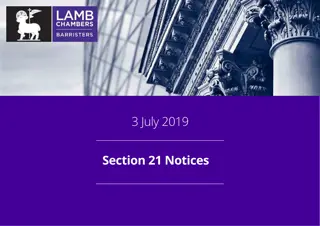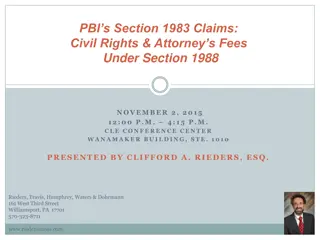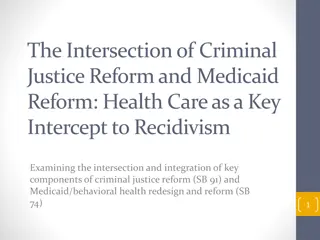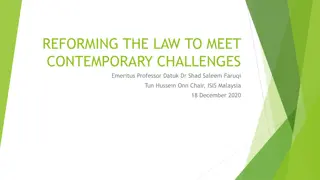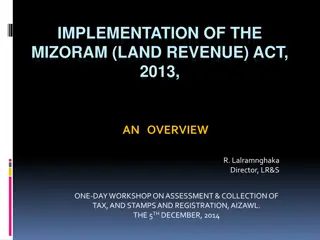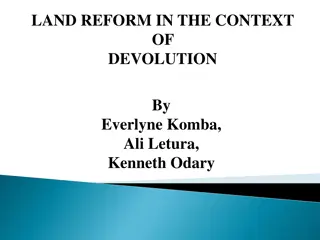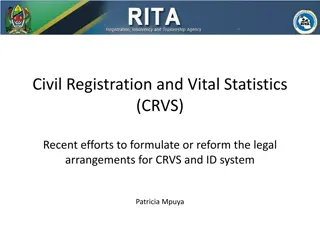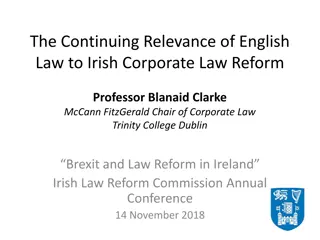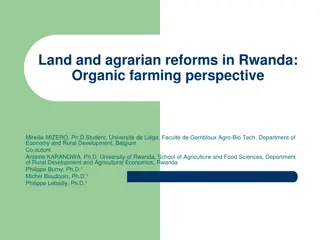Land Law Reform Act 2009: Section 31 Applications Overview
This overview delves into Section 31 of the Land and Conveyancing Law Reform Act 2009, discussing the broader locus standi test for applicants seeking court orders related to co-owned land. It also touches on potential plaintiff categories under Section 31(1), covering aspects like qualified cohabitants and disputes arising from terminated marriage agreements.
Download Presentation

Please find below an Image/Link to download the presentation.
The content on the website is provided AS IS for your information and personal use only. It may not be sold, licensed, or shared on other websites without obtaining consent from the author.If you encounter any issues during the download, it is possible that the publisher has removed the file from their server.
You are allowed to download the files provided on this website for personal or commercial use, subject to the condition that they are used lawfully. All files are the property of their respective owners.
The content on the website is provided AS IS for your information and personal use only. It may not be sold, licensed, or shared on other websites without obtaining consent from the author.
E N D
Presentation Transcript
Applications pursuant to Section 31 of the Land and Conveyancing Law Reform Act, 2009 Clare O Shea BL
Background Prior to introduction of LCLRA 2009, Partition Act 1868 Section 3, 1868 Act provided that a court could order a sale in lieu of partition where a sale of the property and a distribution of the proceeds would be more beneficial for the parties interested than a division of the property between or among them Parties interested referred to co-owners, therefore of limited application Law Reform Commission Report Reform and Modernisation of Land Law and Conveyancing Law (LRC 74-2005) recommended repeal of Partition Acts Partition Acts repealed pursuant to Land and Conveyancing Law Reform Act 2009, Sch 2, Pt 4.
Section 31 Section 31 (1), 2009 Act provides that: [a]ny person having an estate or interest in land which is co-owned whether at law or in equity may apply to the court for an order under this section. The locus standi test is wider than under Partition Acts. Refers to a broad category of potential applicant, refers to an application being made by any person having a legal or equitable interest in the property in question.
Potential categories of Plaintiff under Section 31(1)? 1. Plaintiff who is a qualified cohabitant but not economically dependent Section 173(1) of Civil Partnership and Certain Rights and Obligations of Cohabitants Act 2010 provides that a qualified cohabitant may apply, inter alia, for an Order under Section 174 Section 173(2) provides that: If the qualified cohabitant satisfies the court that he or she is financially dependent on the other cohabitant and that the financial dependence arises from the relationship or the ending of the relationship, the court may, if satisfied that it is just and equitable to do so in all the circumstances, make the order concerned.
2. Plaintiff who was not engaged to Defendant Section 44, Family Law (Divorce) Act 1996: Where an agreement to marry is terminated, section 36 of the Act of 1995 shall apply, as if the parties to the agreement were married to each other, to any dispute between them, or claim by one of them, in relation to property in which either or both of them had a beneficial interest while the agreement was in force. Section 36(1), Family Law Act 1995: Either spouse may apply to the court in a summary manner to determine any question arising between them as to the title to or possession of any property. Section 36(2), Family Law Act 1995 provides that, on application to it under subsection (1), the court may: a) make such order with respect to the property in dispute (including an order that it be sold or partitioned) and as to the costs consequent upon the application, and b) direct such inquiries, and give such other directions, in relation to the application, as the court considers proper.
3. Financially/economically dependent qualified cohabitant who is out of time Section 195, 2010 Act provides that: Proceedings under this Part other than proceedings under section 173(6) and 194 , shall, save in exceptional circumstances, be instituted within 2 years of the time that the relationship between the cohabitants ends, whether through death or otherwise. s. 173(6) - variation s. 194 provision out of estate of deceased
4. Where the fact of qualified cohabitation / financial dependence is disputed or in question M.W. v D.C. [2020] 3 IR 569, Ms. Justice Mary Finlay Geoghegan: where there are dependent children, a person must be a cohabitant of the other adult within the meaning of s. 172(1) during the entirety of the period of two years immediately before the time when the relationship upon which the claim is brought ended. Bring concurrent proceedings? 5. Where Plaintiff has not been declared a qualified cohabitant and therefore not entitled to seek Property Adjustment Order Previous unsuccessful application under 2010 Act
Section 31(2) - Orders a Plaintiff with standing can seek Section 31(1), LCLRA 2009 provides that [a]ny person having an estate or interest in land which is co-owned whether at law or in equity may apply to the court for an order under this section Those Orders set out in subsection (2)
Section 31(2) LCLRA 2009 provides than an order under this section includes a) an order for partition of the land amongst the co-owners, b) an order for the taking of an account of incumbrances affecting the land, if any, and the making of inquiries as to the respective priorities of any such incumbrances, c) an order for sale of the land and distribution of the proceeds of sale as the court directs, d) an order directing that accounting adjustments be made as between the co- owners; e) an order dispensing with consent to severance of a joint tenancy as required by section 30 where such consent is being unreasonably withheld, f) such other order relating to the land as appears to the court to be just and equitable in the circumstances of the case.
Section 31(2) (a) Partition Where the co-owners/person with beneficial interest do not agree to partition of the land, a person holding an estate or interest in land could apply to court for an order of partition. Very rare in practice Must be feasible Yippi Trading Company Ltd v. Costello [2013] IEHC 564 (Ryan J.) Application for partition of a car park Ryan J. dismissed the application for partition without making any order. Partition was not the answer to this application. For partition to be ordered, it had to be feasible in both a practicable and legal sense.
Section 31(2) (b) and (c) Sale Where the co-owners/person with a beneficial interest do not agree to sale of the land, a person holding an estate or interest in land could apply to court for an order of sale. Court has discretion as to how sale proceeds are distributed distribution of the proceeds of sale as the court directs
Section 31(2)(c) specifically contemplates an order for sale and division of the proceeds being granted to an applicant with standing under s 31(1). Section 31 leaves it open to the court to decide when it is appropriate to order a sale, without imposing any presumptions based on the nature of the applicant s interest or size of his or her share. Under Section 31 there is no need to establish a particular reason for ordering sale, while those co-owners who oppose such an order do not need to put forward specific objections or establish positive reasons against sale. Can apply as of right Such arguments will be made as part of the pleadings, in an attempt to influence the court s decision.
Section 31 Discretion of the Court Section 31(2)(f) court can make such other order relating to the land as appears to the court to be just and equitable in the circumstances of the case Section 31(3), the court may: a) make an order with or without conditions or other requirements attached to it, or b) dismiss the application without making any order, or c) combine more than one order under this section.
The court has a broad discretion in deciding whether to make an order under Section 31. There is no statutory checklist of factors which it must take into account when reaching its decision, like in Section 16, Family Law Act 1995 or Section 20, Family Law (Divorce) Act 1996 Important to note that the range of potential orders available to the court is wider than that listed in Section 31(2) Legislation makes it clear that an order under Section 31 merely includes those listed while Section 31(2)(f) specifically authorises the court to make any order it regards as being just and equitable in the circumstances. E.g. One possibility might be an order that the co-owner who opposes sale be permitted to purchase the share of the party seeking sale (subject to appropriate safeguards being imposed on any consequent undertaking to purchase).
No provision for a County Registrar Order as per Section 9(5) 1995 Act or Section 14(5) 1996 Act Section 31(2)(f) might provide basis for the same just and equitable
Section 31(4)(b) - accounting adjustments, include: (i) payment of an occupation rent by a co-owner who has enjoyed, or is continuing to enjoy, occupation of the land to the exclusion of any other co-owner, (ii) compensation to be paid by a co-owner to any other co-owner who has incurred disproportionate expenditure in respect of the land (including its repair or improvement), (iii) contributions by a co-owner to disproportionate payments made by any other co-owner in respect of the land (including payments in respect of charges, rates, rents, taxes and other outgoings payable in respect of it), (iv) redistribution of rents and profits received by a co-owner disproportionate to his or her interest in the land, (v) any other adjustment necessary to achieve fairness between the co-owners.
How does a Court ascertain parties respective interests under Section 31? Very little caselaw on Section 31 in this context One reported Circuit Court case McGrane v. O Foghlu[2020] IECC 1, O Connor J. Circuit Court was asked to determine the equitable interest of each of the cohabiting parties in the premises the parties lived in as family home. Property purchased in 1996 jointly but without an explicit declaration of the respective beneficial interests of the parties.
Facts and parties positions - McGrane v O Foghlu The defendant, Mr O Foghlu, submitted that the court should carry out an analysis on the basis of the capital sums paid by each party. The plaintiff, Ms McGrane, submitted that the premises was purchased jointly in 1996 and the common intention of the parties at the date of purchase up to the date of the separation was that the property was jointly owned. The plaintiff also submitted that the contributions of the parties should be looked at on the basis that all payments were made as a family unit and not just capital and mortgage payments. The plaintiff s point of view was that the starting point was that the common intention of the parties at the date of purchase was that the premises was to be held jointly, so that in the event of the death of one party, the surviving party would take advantage of the right to survivorship. The plaintiff relied on the case of Stack v. Dowden [2007] UKHL 17
Discussion McGrane v OFoghlu O Connor J. Para 21 onwards: 1. In a domestic relationship such as this, the court therefore has to consider the issues of legal and beneficial ownership, and how if any do the equitable issues of estoppel, resulting trusts and constructive trusts impact on the parties ownership. 2. Court also has to also evaluate if the intention of the parties impacts on this analysis. 3. Finally, the court has to consider if the well know maxim of equity, equity follows the law , i.e. equity will not lightly overrule legal requirements
Discussion McGrane v OFoghlu Hilary Biehler's, Equity and the Law of Trusts in Ireland (7th edn, Round Hall 2019) Resulting trust can be said to arise by implication and is founded on the unexpressed but presumed intention of the settlor. Also sometimes referred to as implied trusts because they are presumed to arise as a result of the settlor's implied intention. Constructive trust is a form of trust which arises by operation of law and which ordinarily comes into being as a result of conduct and irrespective of the intentions of the parties. In general terms it can be described as a trust which is imposed by equity in order to satisfy the demands of justice and good conscience The main distinction between resulting and constructive trusts is that in the case of the former, the court assumed that the creation of the trust was intended by the parties, whereas in the latter instance the trust is imposed by the court to satisfy the demands of justice and good conscience . This court imposition can be contrary to the intentions of the individuals concerned.
Held: Starting point was that there was a presumption that where the parties were joint tenants in law, they would also be in equity. No indication that the parties ever envisaged that it would be otherwise until the relationship ended in August 2015. Irrespective of whether one was to adopt an approach which focused on the intention of the parties or the contribution of the parties, the fact was they operated as a family unit during the period of purchase, mortgage and enhancement of the premises; the fact the salaries were paid into separate bank accounts (of which they both had access to) did not alter the situation. He held that this was a property held at all times in law and equity in equal shares. Defendant had not shown sufficient reason why he should be given a greater share in the premises. While it was not necessary to consider the facts on the basis of a resulting trust (i.e. contributions), if O Connor J had, he would have come to the same conclusion as to equal ownership of the premises; it appeared from the comprehensive evidence furnished to the court that it was in effect an equal contribution by each of the parties.
Impact of Stack v Dowden? Prior to Stack v Dowden, the default position for contributions to family homes was provided for in Lloyds Bank plc v Rosset [1990] UKHL; 144 [1991] 1 AC 107 and Pettitt v Pettitt [1970] AC 777. In those cases, the costs of running the household and improvements made to a property did not in itself create a beneficial interest in the property. I.e., determined on the basis of resulting trust. This applied irrespective whether the property was a family home or not. The net effect is that the presumption of a resulting trust would operate and that each parties beneficial interest was determined proportionately to their contribution to the purchase price.
Stack v Dowden [2007] UKHL 17 Conveyance into the joint names of a cohabiting couple, but without an explicit declaration of their respective beneficial interests, of a dwelling house which was to become their home. House of Lords held in a majority Judgment (per Baroness Hale of Richmond) that the presumption of a resulting trust is no longer conclusive as to the beneficial interest in a family property after the breakdown of a cohabitation relationship. There is a presumption of equality of beneficial interests Party had to prove common intention that their beneficial interests were different to their legal interests In that case the court found that, in the light of changing social and economic conditions, it was entitled to depart from apportionment rules which would apply to a resulting trust. Therefore, where there is evidence that the parties conduct in relation to property justified an inference of common intention, a court could hold that a constructive trust was created.
Stack v Dowden [2007] UKHL 17 How do you determine intention? As Baroness Hale observed at para 69: In law, context is everything and the domestic context is very different from the commercial world. Each case will turn on its own facts. Many more factors than financial contributions may be relevant to divining the parties' true intention. These include: any advice or discussions at the time of the transfer which cast light upon their intentions then; the reasons why the home was acquired in their joint names; the reasons why (if it be the case) the survivor was authorised to give a receipt for the capital moneys; the purpose for which the home was acquired; the nature of the parties' relationship; whether they had children for whom they both had responsibility to provide a home; how the purchase was financed, both initially and subsequently; how the parties arranged their finances, whether separately or together or a bit of both; how they discharged the outgoings on the property and their other household expenses .
Stack v Dowden Good law in Ireland? Stanley v. Kieran [2011] IESC 19 Parties cohabited 1983 1994 Property in Kilkenny, registered in the name of a company originally, share capital of which was in the Respondent s name Appellant sought, inter alia, declaration that he was beneficial owner of the property or that the Respondent held the share capital in company in trust for him. Respondent denied that property had been so bought / that he was estopped by reason of his conduct and representations. Denham J.: Para 28 - Presumption that the provider of funds is the beneficial owner; however that presumption may be rebutted (Para 29) Supreme Court relied on doctrine of resulting trust in determining parties respective interests
Kenny v Kenny [2019] IEHC 76 Claim in relation to proceeds of mortgage protection policy not in a cohabitation scenario. Grandfather v. granddaughter O Connor J. quoted Baroness Hale in Stack v Dowden with apparent approval.
OMalley v. Breen O Malley v. Breen [2021] IECA 148 Facts: Probate case. Appellant (Kay Breen) former spouse of Conor Breen (deceased) Second respondent (Mary Breen) widow of Conor Breen Kay Breen and Conor Breen estranged and separated in 1994, remained cordial and divorced 2007 Deceased and Mary Breen in long term relationship and cohabiting since 1995, Married 2017. Property in Dundalk purchased in joint names of Kay Breen and Conor Breen in 2000. Deceased renovated and collected rent etc. Mortgage on Dundalk property subsequently redeemed and property cross-secured by Deceased and second wife to purchase holiday home without Kay Breen s knowledge Executore argued that the intention was that the Dundalk property be conveyed to Deceased and Mary Breen at the time HCT found KB held 58% of property in trust for deceased estate
Arguments: Executor/Mary Breen argued, inter alia, that Dundalk property held in resulting trust for deceased Kay Breen argued, inter alia, that the Dundalk property was held as joint tenants and no severance of JT relied heavily on Stack v Dowden to rebut
Haughton J., Para 78: In my view in Stack there may have been good reason for adopting the use of the constructive trust as a device for determining the beneficial interest in homes purchased by unmarried couples whether in one name or in joint names at a time when family law legislation, that now gives the courts greater discretion and powers in relation to determination of beneficial interests and the making of financial and property adjustment orders, did not apply to them. Cognisant that in Stanley v Kieran the Irish Supreme Court applied the presumption of a resulting trust to resolve a dispute as to beneficial ownership between a cohabiting couple in respect of property acquired at a time when they were still cohabiting. Therefore, court should be slow to resort to a constructive trust when this dispute is not between co-habitees, and does not relate to a family home , that this court should, at least in the first instance, apply existing rules and presumptions. It should be inferred that the property should be held legally and beneficially in equal shares
Section 31 - practicalities Applications to the court are by way of Equity Civil Bill in Circuit Court Order 46A CCR Equity Civil Bill in accordance with Form 2B CCR 3,00,000 jurisdiction Applications by Special Summons in High Court Order 72A
Section 31 - Pleadings Establish basis for legal of beneficial interest under Section 31 contributions, co-owner etc Full description of the property
References Maddox, The Land and Conveyancing Law Reform Acts: A Commentary Wylie, Wylie on Irish Land Law Conway, Co-Ownership of Land: Partition Actions and Remedies
